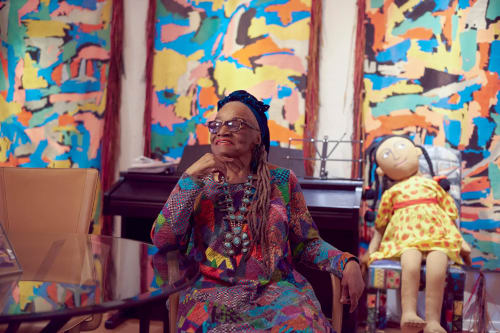A champion of Black artists, she explored themes of race, gender, class, family and community through a vast array of media and later the written word.
Faith Ringgold, a multimedia artist whose pictorial quilts depicting the African American experience gave rise to a second distinguished career as a writer and illustrator of children's books, died on Saturday at her home in Englewood, N.J. She was 93.
Her death was confirmed by Emily Alli, who is helping with Ms. Ringgold's estate.
For more than half a century, Ms. Ringgold explored themes of race, gender, class, family and community through a vast array of media, among them painting, sculpture, mask- and dollmaking, textiles and performance art. She was also a longtime advocate of bringing the work of Black people and women into the collections of major American museums.
Ms. Ringgold's art, which was often rooted in her own experience, has been exhibited at the White House and in museums and galleries around the world. It is in the permanent collections of the Metropolitan Museum of Art, the Guggenheim Museum, the Schomburg Center for Research in Black Culture and the American Craft Museum in New York; the Philadelphia Museum of Art; the Museum of Fine Arts in Boston; and other institutions.
For Ms. Ringgold, as her work and many interviews made plain, art and activism were a seamless, if sometimes quilted, whole. Classically trained as a painter and sculptor, she began producing political paintings in the 1960s and '70s that explored the highly charged subjects of relations between Black and white people, and between men and women, in America.
"Few artists have kept as many balls in the air as long as Faith Ringgold," the New York Times art critic Roberta Smith wrote in 2013, reviewing an exhibition of her work at ACA Galleries in Manhattan. "She has spent more than five decades juggling message and form, high and low, art and craft, inspirational narrative and quiet or not so quiet fury about racial and sexual inequality."
The hallmarks of Ms. Ringgold's style included the integration of craft materials like fabric, beads and thread with fine-art materials like paint and canvas; vibrant, saturated colors; a flattened perspective that deliberately evoked the work of naïve painters; and a keen, often tender focus on ordinary Black people and the visual minutiae of their daily lives.
Critics praised Ms. Ringgold's work from the beginning. But wide renown, in the form of exposure in the country's most prestigious museums, largely eluded her until midlife - a consequence, she often said, of her race, her sex and her uncompromising focus on art as a vehicle for social justice.
"In a world where having the power to express oneself or to do something is limited to a very few, art appeared to me to be an area where anyone could do that," she told The Orlando Sentinel in 1992. "Of course, I didn't realize at the time that you could do it and not have anyone know you were doing it."
Ms. Ringgold ultimately became best known for what she called "story quilts": large panels of unstretched canvas, painted with narrative scenes in vivid acrylics, framed by quasi-traditional borders of pieced fabric and often incorporating written text. Meant for the wall rather than the bed, the quilts tell of the joys and rigors of Black lives - and, in particular, of Black women's lives - while simultaneously celebrating the human capacity to transcend circumstance through the art of dreaming.
One of her most celebrated story quilts, "Tar Beach," completed in 1988, gave rise to her first children's book, published three years later under the same title. With text and original paintings by Ms. Ringgold, the book, like the quilt, depicts a Black family convivially picnicking and slumbering on the roof of their Harlem apartment building on a sultry summer's night.
"Tar Beach" was named a Caldecott Honor Book by the American Library Association and one of the year's best illustrated children's titles by The New York Times Book Review. It has endured as a childhood staple and garnered a string of other honors, including the Coretta Scott King Award, presented by the library association for distinguished children's books about African American life.
Ms. Ringgold went on to illustrate more than a dozen picture books, most with her own text, including "Aunt Harriet's Underground Railroad in the Sky" (1992), about Harriet Tubman, and "If a Bus Could Talk: The Story of Rosa Parks" (1999).
Her eminence in the field is all the more striking in that she never set out to be a children's author in the first place.
Apr 13, 2024
1
of 117

